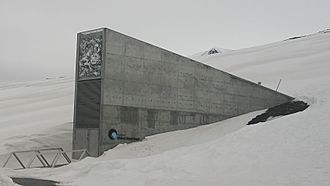Svalbard Global Seed Vault facts for kids
Quick facts for kids Svalbard Global Seed Vault |
|
|---|---|
|
Svalbard globale frøhvelv
|
|
 |
|
| General information | |
| Status | Complete |
| Type | Seed bank |
| Location | Spitsbergen |
| Town or city | Longyearbyen |
| Country | Norway |
| Coordinates | 78°14′09″N 15°29′29″E / 78.235867°N 15.491374°E |
| Elevation | 130 m (430 ft) |
| Groundbreaking | 19 June 2006 |
| Opened | 26 February 2008 |
| Cost | 45 million kr (US$8.8 million, 2008) |
| Technical details | |
| Floor count | 1 |
| Floor area | c. 1,000 m2 (c. 11,000 sq ft) |
| Awards and prizes | Norwegian Lighting Prize for 2009 No. 6 TIME's Best Inventions of 2008 |
The Svalbard Global Seed Vault (Norwegian: Svalbard globale frøhvelv) is a seed bank (a place where seeds are kept) in Norway. It is on the island of Spitsbergen, near Longyearbyen, in the Arctic Svalbard archipelago. It is about 1,300 kilometres (810 miles) from the North Pole. Conservationist Cary Fowler worked with the Consultative Group on International Agricultural Research (CGIAR), to start the vault.
The vault is there to save many different kinds of plant seeds. The seeds at the vault are copies of seeds from other places around the world. Copies of seeds are kept in case the seeds in other places are lost. Three organizations decided how to manage the vault. Those organizations were the Norwegian government, the Global Crop Diversity Trust (GCDT) and the Nordic Genetic Resource Center (NordGen).
The Norwegian government paid for building the vault. It cost about 45 million Norwegian kroner (US$9 million) to build. Storing seeds in the vault is free. Norway and GCDT pay to operate the vault. GCDT gets money from organisations such as the Bill & Melinda Gates Foundation and from different governments worldwide.
Images for kids
See also
 In Spanish: Banco Mundial de Semillas de Svalbard para niños
In Spanish: Banco Mundial de Semillas de Svalbard para niños



